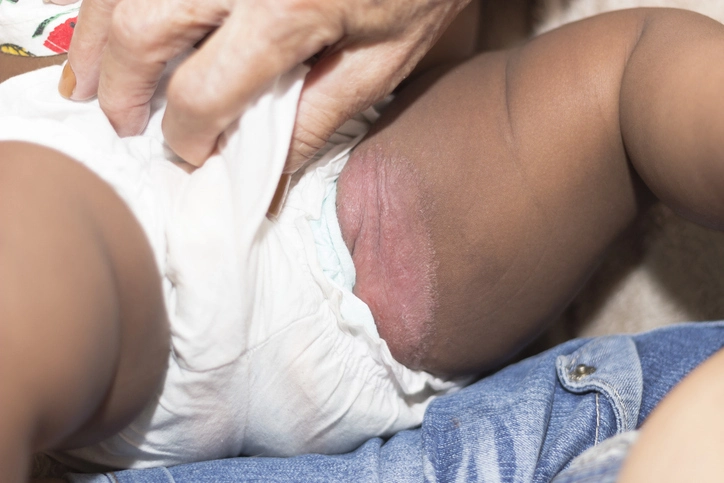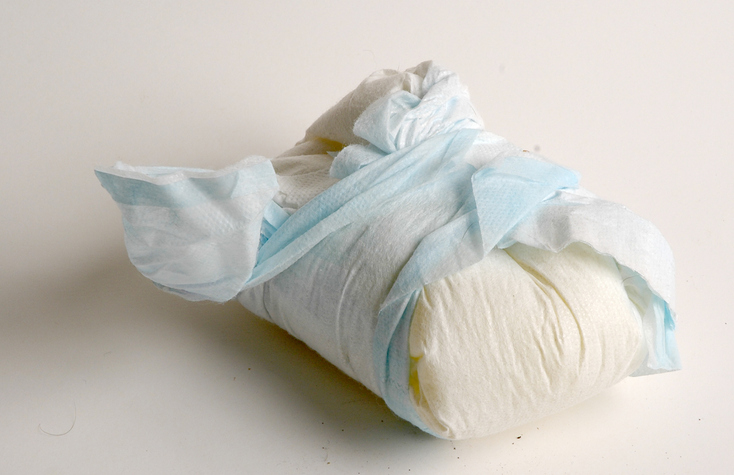Dealing with diaper rash can be a real hassle for parents. While parents can take steps to prevent diaper rash, it is still common—at least half of all babies get one.
Don't stress— Dr. Rachel Tellez and Dr. Melissa Tribuzio from Blueberry Pediatrics have your back with tips and tricks for managing diaper rash effectively so you can be prepared if it happens.
Keep reading to learn about the different types of diaper rash, what causes them, how to spot them, how to treat them, and most importantly, how to prevent them. We’re here to help you tackle this challenge with confidence!
What is diaper rash?

Diaper rash refers to irritation or redness in the areas covered by a baby’s diaper. It occurs when a baby's diaper is in prolonged contact with a soiled diaper or due to allergies or infections. Diaper rash is typically tender and sometimes itchy and can cause significant discomfort for babies.
More than half of all babies experience diaper rash at some point, usually between 4 and 15 months.
Diaper rash symptoms
Common symptoms of a baby's diaper rash include red, inflamed, tender skin on the buttocks, thighs, and genitals. The rash can cause discomfort and pain, sometimes accompanied by a strong odor. Severe cases may have blisters or oozing pus.
Diaper rash causes
Several factors can increase the risk of diaper rash, such as infrequent diaper changes (which lead to prolonged exposure to wet or soiled diapers), sensitive skin, poor hygiene, and friction from diapers.
Types of diaper rash

There are three primary types of diaper rash: irritant diaper dermatitis, yeast infection, and allergic reaction. Each type presents distinct symptoms and requires specific care to ensure the baby’s comfort and skin health.
Irritant diaper dermatitis
Irritant diaper dermatitis is the most common type of diaper rash, and it is caused by prolonged contact with urine or stool. The rash is typically red and shiny and confined to the area in contact with the diaper. Treatment involves using barrier ointments like zinc oxide or petroleum jelly to protect the skin.
Candida diaper rash
A candida, or yeast, diaper rash is caused by Candida albicans, a fungus that thrives in warm, moist environments. The rash is red, often spreading to the inner thighs, with “satellite lesions” – red dots outside the main rash. Treatment requires applying antifungal creams such as clotrimazole 1% (Lotrimin AF) twice a day and using barrier ointments on top of the antifungal cream.
Bacterial diaper rash
Bacteria like Staphylococcus aureus can cause bacterial diaper rashes. These rashes are bright red, sometimes with small blisters or yellow crusting. Severe cases may show peeling skin. A doctor can diagnose bacterial diaper rashes and prescribe an antibacterial cream as a treatment.
<div fs-richtext-component="cta" class="content_cta">
<div class="content-cta__title">
<div class="y-tex-xxs text-color-white">
Blueberry - Rated best for online pediatrics!
</div>
</div>
<div class="y-text-2xl text-color-white">
👩🏽⚕️ Chat With A Pediatrician About Your Baby's Diaper Rash
</div>
<a href="https://app.blueberrypediatrics.com/join_blueberry_18a_cart?promo=blog100"
target="_blank" class="content-cta_btn w-button">
Get Started
</a>
<link rel="prefetch" href="https://app.blueberrypediatrics.com/join_blueberry_18a_cart?promo=blog100">
Less common types of diaper rash
Other skin conditions that may cause diaper rash include eczema, psoriasis, seborrheic dermatitis, and heat rash.
Eczema
Although it is uncommon for eczema to appear in the diaper area, it is possible if the baby has moderate eczema elsewhere. The rash is typically dry and itchy. It can be managed with mild soaps, moisturizers, and barrier creams or ointments. In some cases, a doctor may prescribe steroid treatment.
Psoriasis
Like eczema, psoriasis rarely appears in the diaper area but can appear as a red and silver rash. Psoriasis can closely resemble a diaper rash or yeast infection, so consult a doctor for an accurate diagnosis and treatment plan.
Seborrheic dermatitis
Seborrheic dermatitis is a condition that appears as splotchy red patches with scaling and are greasy and yellow. It commonly affects the face, ears, armpits, and scalp; in some cases, it can appear in the diaper area. Treatment starts with barrier creams; if there's no improvement, a doctor may prescribe antifungal or low-dose steroid creams.
Heat rash
Heat rash consists of tiny bumps caused by hot, unventilated skin. Treatment involves cooling and promoting airflow.
Preventing diaper rash

The best way to prevent diaper rash is to keep the diaper area clean and dry. This includes changing diapers frequently, especially after the baby has a stool, and using superabsorbent disposable diapers to wick moisture away from the skin.
For families who use cloth diapers, changing diapers frequently, washing them with gentle detergents, and using diaper liners can help prevent bacterial and fungal growth. Wash cloth diapers with fragrance-free detergents to prevent allergic reactions in infants.
If your baby gets frequent diaper rashes, preventive barrier creams and ointments like zinc oxide or petroleum jelly can be used regularly. Using fragrance-free and hypoallergenic products can also help prevent diaper rashes.
How to treat diaper rash

Diaper rash is very common and doesn't necessarily need immediate evaluation by a pediatrician. If your little one is otherwise well, the first step is more frequent diaper changes, as a clean and dry diaper area is crucial in treating a baby's rash.
During diaper changes, gently wipe the area with a soft cloth or cotton ball soaked in warm water. Avoid wipes containing alcohol, fragrances, or other irritants, as they can aggravate the rash.
After cleaning your baby's bottom, allow it to air dry before applying barrier ointment and putting on a new diaper.
If your baby has a severe diaper rash, you may want to consider letting them go without a diaper for short periods to allow their skin to air out.
If you don't see improvement or the rash worsens after two or three days of home treatment, consult your child's pediatrician. Also, if you notice other concerning symptoms (fever, not feeding, pimples, blisters), consult your child's pediatrician immediately.
Your pediatrician may prescribe a medicated cream or ointment or diagnose other issues or conditions.
Additional tips for treating diaper rashes
Parents may receive many suggestions from the internet and other families on treating their baby's diaper rash - from at-home treatment to diaper rash products to try - it can be overwhelming! Dr. Tellez offers a few tips that may help you feel a little less confused.
Avoid "all-natural" products with potential allergens
Dr. Tellez advises families to be careful about selecting “all natural” barrier ointments because they often have “natural” or “organic” ingredients added. "Some of these ingredients - like lavender, almond, or coconut oil - may cause their own reactions," says Dr. Tellez.
How to properly apply barrier cream
When applying barrier creams or ointments, apply a layer all over the rash and leave it on. The ointment will stick to the irritated skin and protect it from exposure to urine, stool, or the diaper.
She says, "You don’t need to remove the ointment when changing wet diapers - you can gently blot any liquid there and add another layer. If the diaper has stool, then the ointment needs to be cleaned up."
Apply barrier cream with ingredients like zinc oxide (found in Desitin, A&D, Boudreaux’s Butt Paste, and Triple Paste). You can also apply barrier ointments with petroleum jelly, found in Vaseline (the kind in the yellow jar) and Aquaphor Diaper Rash Ointment.
Products to avoid or use with caution
Dr. Tellez does not recommend applying baby powder to your little one's bottom. "Baby powders can get in the air, and babies can inhale them, leading to lung problems."
Additionally, avoid:
- Using cornstarch or witch hazel in your baby's diaper area, as these can irritate the skin.
- Applying baking soda directly to your baby's rash; baking soda baths are okay and can soothe raw skin.
- Wiping your baby with diaper wipes if they have a very sore rash; instead, use a soft washcloth and plain water as they can be gentler on the baby’s skin.
Get care for your little one with Blueberry Pediatrics
While diaper rash can be uncomfortable for the baby and a hassle for the parents, it's a common, manageable condition that should resolve in a few days with proper care. If you have more questions or want guidance for a rash your baby is experiencing, Blueberry Pediatrics has you covered!
Blueberry Pediatrics, one of the largest pediatric practices in the US, offers unlimited, on-demand access to board-certified pediatricians who can provide personalized treatment plans for your little one's specific needs.
Chat with a pediatrician through text, call, or video about diaper rash - or any symptoms your child is experiencing. No question or issue is too big or too small!
Best of all, you can get help quickly without leaving the comfort of your home for one low monthly or annual price. It takes just minutes to sign up, and you can chat with a pediatrician immediately upon joining.
.png)
Frequently Asked Questions
What's the cause of my baby's diaper rash?
There are three primary culprits behind diaper rash. The most common culprit is when your baby's skin has prolonged contact with urine or stool. The resulting rash is called irritant diaper dermatitis; it is typically red, shiny, and confined to the area in contact with the diaper.
Another cause of diaper rash is yeast growth, which is known as a Candida diaper rash. This rash is red and often spreads to the inner thighs, with “satellite lesions”—red dots outside the main rash.
Lastly, a bacterial infection can be a cause of diaper rash. These rashes are bright red, sometimes with small blisters or yellow crusting, and require antibiotics for treatment.








.svg)






.svg)
.svg)